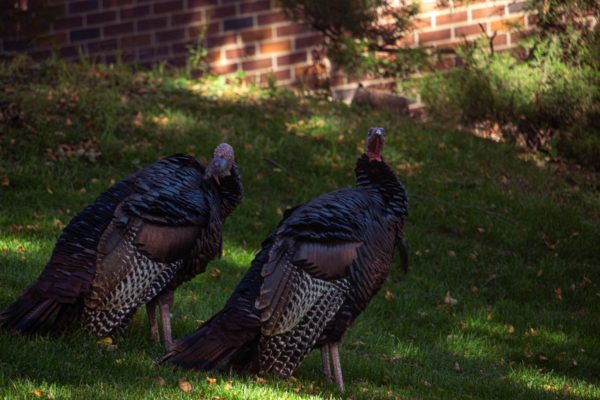You’re preparing to leave your dorm on a chilly fall morning. Nothing can break the monotony of overcast skies and dull professors. You step outside without even thinking of your surroundings, too busy second-guessing your life choices.
Suddenly, a violent crash breaks the early morning silence, and you whip your head toward the sound, fearing you’re about to witness a SAFE-U alert in real time.
Instead, you only see a flock of turkeys.
One of the creatures snapped a massive tree branch cleanly to the ground after attempting to perch on it.
You can’t help but smile and roll your eyes. There’s no place like the University of Minnesota.
Kian Roemer, a first-year student at the University, said he likes seeing flocks of turkeys on campus because they are interesting for an urban area.
Campus turkeys appear at random locations across the University with seemingly no regard for students or faculty. Roemer said he frequently sees turkeys in front of buildings on Northrop Mall.
Abednett Browne, a third-year student at the University, said she sees turkeys most often near Superblock, Pillsbury Drive and Church Street.
In short, they’re everywhere.
The spontaneity of turkey appearances helps ward away my depression, and probably other students, too. It’s impossible to be sad when a tall, peculiar bird is present to remind you of the simplicity of life, waddling across a busy street without caring whatsoever.
Also, turkeys are a sign our campus excels as a healthy urban ecosystem.

James Forester, an associate professor in the Department of Fisheries, Wildlife and Conservation Biology at the University, leads the Twin Cities Coyote and Fox Project which tracks and studies foxes and coyotes in the urban area.
According to Forester, the Twin Cities are unique compared to other large cities due to the abundance of urban wildlife. Forester said having animals like turkeys in cities helps maintain an ecosystem and keep diseases, insects and other animals in check.
“Lyme disease is a great example of the interconnectedness of the natural system and humans,” Forester said. “It’s carried by black-legged ticks, also known as deer ticks, and their life cycle involves multiple species.”
Forester said deer ticks feed on both white-footed mice and white-tailed deer throughout their lives, so if the population of mice explodes out of control, the deer tick population increases, too. This heightens the risk of Lyme disease transmission to humans.
“One of the main ways you control mice is with mesocarnivores, and that’s going to be foxes and coyotes,” Forester said. “That’s what they specialize in. So if you don’t have those predators involved, you don’t have a big cap on the growth of the small mammal population.”
Turkeys play a role in balancing the urban ecosystem just like foxes, coyotes and any other creature. According to the Minnesota Department of Natural Resources, insects are a primary part of turkeys’ diet, in addition to seeds and plants.
Tom Ritzer, assistant director of Landcare, part of Facilities Management at the University, said turkeys spend much of their time on campus digging up soil to eat insects and plants.
Not only does this help maintain equilibrium in the ecosystem, but Ritzer said it also can help the Landcare team locate certain grubs that cause patches of dead grass.
Campus turkeys peacefully coexist with the University’s human community — most of the time.
“During freshman year, I saw them chasing someone,” Browne said.
Ritzer said turkeys are not always helpful to the Landcare team. He added that turkeys digging in lawns makes a mess that is difficult to clean up.
“They will sometimes perch in trees above sidewalks and then defecate the sidewalks,” Ritzer said. “We have that problem with crows also, but turkey droppings are pretty nasty, so we get calls when that happens.”
Encountering campus turkeys for the first time can come as a surprise.
“I could see it being a little alarming if there’s a big group of them nearby,” Roemer said. “I know some birds — for example, geese — tend to be a little aggressive towards people.”
Until the turkeys actually cause a SAFE-U alert, though, I believe their benefits outweigh the cons.
“There are opportunities to interact with wildlife right here in our backyards if we just take the time to look,” Forester said. “And it can be as magical as seeing animals in a remote place. In fact, in some ways it’s even more curious because they’re right here, living amongst us.”
Having wildlife, like turkeys, in an urban area gives nature a place in our day-to-day lives that we could otherwise only see by traveling.
“Not everyone wants to or has the capacity or experience to go out into the Boundary Waters or some other kind of wilderness area,” Forester said. “It takes a fair bit of commitment, time and expertise to do so.”
I reached out to one of the campus turkeys for comment but received no reply. The turkey merely walked away from me and continued to peck at grass in the Knoll.
Hopefully, they will take this column in good grace.
